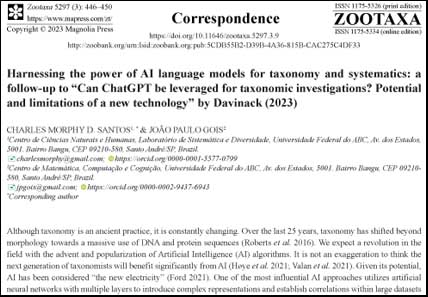Abstract
N/A
References
Alkaissi, A. & McFarlane, D. (2023) Artificial hallucinations in ChatGPT: implications in scientific writing. Cureus, 15 (2), e35179. https://doi.org/10.7759/cureus.35179
Brown, T.B., Mann, B., Ryder, N., Subbiah, M., Kaplan, J., Dhariwal, P., Neelakantan, A., Shyam, P., Sastry, G., Askell, A., Agarwal, S., Herbert-Voss, A., Krueger, G., Henighan, T., Child, R., Ramesh, A., Ziegler, D.M., Wu, J., Winter, C., Hesse, C., Chen, M., Sigler, E., Litwin, M., Gray, S., Chess, B., Clark, J., Berner, C., McCandlish, S., Radford, A., Sutskever, I. & Amodei, D. (2020) Language models are few-shot learners. Advances in Neural Information Processing Systems, 33, 1877–1901.
Castelvecchi, D. (2016) Can we open the black box of AI. Nature, 538 (7623), 20–23. https://doi.org/10.1038/538020a.
Curtis, A. & ChatGPT (2023) To ChatGPT or not to ChatGPT? The impact of Artificial Intelligence on academic publishing. The Pediatric Infectious Disease Journal, 42 (4), 275. https://doi.org/10.1097/INF.0000000000003852
Davinack, A.A. (2023) Can ChatGPT be leveraged for taxonomic investigations? Potential and limitations of a new technology. Zootaxa, 5270 (2), 347–350. https://doi.org/10.11646/zootaxa.5270.2.12
Elnathan, R. (2021) English is the language of science — but precision is tough as a non-native speaker. Nature. Available from: https://www.nature.com/articles/d41586-021-00899-y (accessed 5 April 2023) https://doi.org/10.1038/d41586-021-00899-y
Ford, M. (2021) Rule of the robots: how artificial intelligence will transform everything. Basic Books, New York, 320 pp.
Fox, C.W., Meyer, J. & Aymée, E. (2023) Double-blind peer review affects reviewer ratings and editor decisions at an ecology journal. Functional Ecology. [in press] https://doi.org/10.1111/1365-2435.14259
Høye, T.T., Ärje, J., Bjerge, K., Hansen, O.L.P., Iosifidis, A., Leese, F., Mann, H.M.R., Meissner, K., Melvad, C. & Raitoharju, J. (2021) Deep learning and computer vision will transform entomology. PNAS, 118 (2), e2002545117. https://doi.org/10.1073/pnas.2002545117
International Commission on Zoological Nomenclature (ICZN) (1999) International Code of Zoological Nomenclature. 4th Edition. London: International Trust for Zoological Nomenclature, 306 pp.
Liu, X., Zhang, F., Hou, Z., Mian, L., Wang, Z., Zhang, J. & Tang, J. (2021) Self-supervised learning: Generative or contrastive. IEEE Transactions on Knowledge and Data Engineering, 35 (1), 857–876. https://doi.org/10.1109/TKDE.2021.3090866
Ouyang, L., Wu, J., Jiang, X., Almeida, D., Wainwright, C., Mishkin, P., Zhang, C., Agarwal, S., Slama, K., Ray, A., Schulman, J., Hilton, J., Kelton, F., Miller, L., Simens, M., Askell, A., Welinder, P., Christiano, P.F., Leike, J. & Lowe, R. (2022) Training language models to follow instructions with human feedback. Advances in Neural Information Processing Systems, 35 (NeurIPS 2022). Available from: https://proceedings.neurips.cc/paper_files/paper/2022/hash/b1efde53be364a73914f58805a001731-Abstract-Conference.html (accessed 6 April 2023)
Pappas, N. & Meyer, T. (2012) A survey on language modeling using neural networks. Idiap-RR-32-2012. Available from: https://infoscience.epfl.ch/record/192566 (accessed 18 May 2023)
Quintans-Júnior, L.J., Gurgel, R.Q., Araújo, A.A.S., Correia, D. & Martins-Filho, P.R. (2023) ChatGPT: the new panacea of the academic world. Revista da Sociedade Brasileira de Medicina Tropical, 56, e0060. https://doi.org/10.1590/0037-8682-0060-2023
Roberts, A., Austin, W., Evans, K., Bird, C., Schweizer, N. & Darling, K. (2016) A new integrated approach to taxonomy: the fusion of molecular and morphological systematics with type material in benthic Foraminifera. PLoS ONE, 11 (7), e0158754. https://doi.org/10.1371/journal.pone.0158754
Santos, C.M.D., Amorim, D.S., Klassa, B., Fachin, D.A., Nihei, S.S., Carvalho, C.J.B., Falaschi, R.L., Mello-Patiu, C.A., Couri, M.S., Oliveira, S.S., Silva, V., Ribeiro, G.C., Capellari, R.S. & Lamas, C.J.E. (2016) On typeless species and the perils of fast taxonomy. Systematic Entomology, 41 (3), 511–515. https://doi.org/10.1111/syen.12180
Thorp, H.H. (2023) ChatGPT is fun, but not an author. Science, 379 (6630), 313–313. https://doi.org/10.1126/science.adg7879
Valan, M., Vondráček, D. & Ronquist, F. (2021) Awakening taxonomist’s third eye: exploring the utility of computer vision and deep learning in insect systematics. Systematic Entomology, 46 (4), 757–766. https://doi.org/10.1111/syen.12492
van Dis, E.A.M., Bollen, J., Zuidema, W., van Rooij, R. & Bockting, C.L. (2023) ChatGPT: five priorities for research. Nature, 614, 224–226. https://doi.org/10.1038/d41586-023-00288-7


